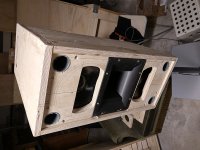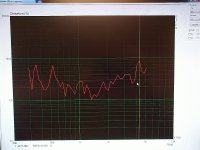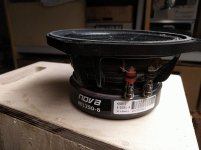Hi.
I´m building a small PA-ish speaker with 2x6" and driver+horn.
(Posting here and not in PA, as I hope for relevant input here)
Crossover is 1.6Khz, 4th order, fully active. 120Vpp amp for mid-basses.
Sound is OK, at moderate levels, but at high levels it becomes "unpleasant".
Amp is not clipping as far as I can see.
The drivers are high-power units with 2"voicecoil and rating of 200/400W pr unit. 91dB/W.
I'm trying to measure distortion with my (cheap) measuring mic and and STEPS/ARTA.
What level of distortion shall I expect? at moderate levels I get around 0.5% and at high levels I get 2-5%. At very high levels I get peaks of 20% distortion at some frequencies.
I will try to capture some waveform and post here.
All inputs are welcome 🙂
Kind regards TroelsM
I´m building a small PA-ish speaker with 2x6" and driver+horn.
(Posting here and not in PA, as I hope for relevant input here)
Crossover is 1.6Khz, 4th order, fully active. 120Vpp amp for mid-basses.
Sound is OK, at moderate levels, but at high levels it becomes "unpleasant".
Amp is not clipping as far as I can see.
The drivers are high-power units with 2"voicecoil and rating of 200/400W pr unit. 91dB/W.
I'm trying to measure distortion with my (cheap) measuring mic and and STEPS/ARTA.
What level of distortion shall I expect? at moderate levels I get around 0.5% and at high levels I get 2-5%. At very high levels I get peaks of 20% distortion at some frequencies.
I will try to capture some waveform and post here.
All inputs are welcome 🙂
Kind regards TroelsM
I'm not the person to answer your questions, but can suggest you let people know which midbass drivers and the tweeter driver / horn you are using.
You need to know whether your measurement setup or the drivers themselves are distorting at high levels. Easiest way is to measure outside groundplane at a large distance to reduce the levels at your mic.
Hope that helps a bit,
Rob.
You need to know whether your measurement setup or the drivers themselves are distorting at high levels. Easiest way is to measure outside groundplane at a large distance to reduce the levels at your mic.
Hope that helps a bit,
Rob.
Agree with Rob regarding the advice to measure outdoors with mic on ground plane. And to make sure mic and measurement software can handle the SPL range.
I don't know/use ARTA...it looks super capable.
But i do know REW has a stepped sine routine that is very useful in measuring THD.
That said, my own experience is that i can't really blame THD for unpleasantness at high levels. I think many things are going on and THD may be the least of them.
AES power ratings are thermal ratings, based on survival.
Compression, and excursion non-linearity kick in way below AES implied pp voltages. Along with a sizeable loss of dynamic capability.
All leading to both an upward and unpleasant tonal balance shift, because the weakened frequency range output is almost inevitably the lower end of a driver's response.
Just my speculations though...no hard proof, just a lot of measurements and head scratching to form the speculations,
Art Welter made a great test on the audibility of compression driver's THD.
It downplays THD's audibility i think.
Don't have a link right now, but if you can't find it let me know and i will.
I don't know/use ARTA...it looks super capable.
But i do know REW has a stepped sine routine that is very useful in measuring THD.
That said, my own experience is that i can't really blame THD for unpleasantness at high levels. I think many things are going on and THD may be the least of them.
AES power ratings are thermal ratings, based on survival.
Compression, and excursion non-linearity kick in way below AES implied pp voltages. Along with a sizeable loss of dynamic capability.
All leading to both an upward and unpleasant tonal balance shift, because the weakened frequency range output is almost inevitably the lower end of a driver's response.
Just my speculations though...no hard proof, just a lot of measurements and head scratching to form the speculations,
Art Welter made a great test on the audibility of compression driver's THD.
It downplays THD's audibility i think.
Don't have a link right now, but if you can't find it let me know and i will.
Thank you for the input. I realize that what I'm hearing may be distortion from the nearby walls or odd stuff vibrating in my basement.
What bothers me most is the steep increase in distortion at high levels when the amp is still not clipping and the drivers are still far from excursion limit
What bothers me most is the steep increase in distortion at high levels when the amp is still not clipping and the drivers are still far from excursion limit
Attachments
Thank you for the input. I realize that what I'm hearing may be distortion from the nearby walls or odd stuff vibrating in my basement.
What bothers me most is the steep increase in distortion at high levels when the amp is still not clipping and the drivers are still far from excursion limit
What bothers me most is the steep increase in distortion at high levels when the amp is still not clipping and the drivers are still far from excursion limit
A little data: I've tried to measure response (gated and with pink noise , indoors, far from ideal) and it looks ok to me. But when I use Steps for single-tone distortion measurement I get a very tagged response. Looks like some nasty resonance?
Distortion at 40Vpp and 80Vpp 60cm distance attached. Yes, I don't know if the mic is also distorting. Freq resp for 40Vpp also attached.
Distortion at 40Vpp and 80Vpp 60cm distance attached. Yes, I don't know if the mic is also distorting. Freq resp for 40Vpp also attached.
Attachments
View attachment 880802Response at high levels and 25db below. Looks identical to me.
Beginning to question my idea about mounting the drivers from back to get them closer and save space. Maybe it result in something nasty that does not show up in all measurements.
Beginning to question my idea about mounting the drivers from back to get them closer and save space. Maybe it result in something nasty that does not show up in all measurements.
Attachments
are you sure you are not measuring distortion generated by the microphone? Try moving the microphone to say 2.4 metres (four times the distance).
The fact you are measuring inside means it will not result in the fundamentsl dropping by an ideal 12dB but should drop a lot. Redo the distortion measurement.
If the distortion is from the speaker itself then it will measure the same relative level to the fundamental.
The fact the fundamental as measured by the mic has dropped means that non linearity in the mic or input stage will be reduced.
Most microphones compress at a faur level, but you are close!!!!
The fact you are measuring inside means it will not result in the fundamentsl dropping by an ideal 12dB but should drop a lot. Redo the distortion measurement.
If the distortion is from the speaker itself then it will measure the same relative level to the fundamental.
The fact the fundamental as measured by the mic has dropped means that non linearity in the mic or input stage will be reduced.
Most microphones compress at a faur level, but you are close!!!!
High levels : 80-120Vpp over 4ohm (8+8), with each driver at 91db/w.
I respect the inputs on my non-ideal measurements, but I cannot do it outdoors right now. I have some experience with a smaller version of this speaker and that one did not become harsh/unpleasant at high level in the same invironment. Leaning towards that it could be some resonance/compression because of the mounting of the drivers.
I respect the inputs on my non-ideal measurements, but I cannot do it outdoors right now. I have some experience with a smaller version of this speaker and that one did not become harsh/unpleasant at high level in the same invironment. Leaning towards that it could be some resonance/compression because of the mounting of the drivers.
What level of distortion shall I expect? at moderate levels I get around 0.5% and at high levels I get 2-5%. At very high levels I get peaks of 20% distortion at some frequencies.
That alone doesn't seem too bad to me, provided the larger distortion is at low frequencies. Under 1% (-40dB) is OK. (I can't make any sense of your unlabeled photos of something or other.)
B.
Last edited:
Sorry for the lousy documentation on this. Posting from a phone. Will get back with better description. The distortion appears to be distributed over the entire spectrum. Would that be a sign of overloaded mic?
What SPL level is that? 80 - 120V p2p? into 4 ohms that's over 1600W and you are measuring at 0.6M?
If that is how much power you are putting into such efficient drivers and you are in a small room with them, I hope you haven't permanently damaged your hearing!
Typical measurememt mics will only handle up to maybe 110db, so I would say it is highly likely you are overloading the mic..
Tony.
If that is how much power you are putting into such efficient drivers and you are in a small room with them, I hope you haven't permanently damaged your hearing!
Typical measurememt mics will only handle up to maybe 110db, so I would say it is highly likely you are overloading the mic..
Tony.
120vpp would be around 200w/driver.
Wearing hearing protection while doing this.
Single tones at these levels are crazy loud
Wearing hearing protection while doing this.
Single tones at these levels are crazy loud
Last edited:
That way of mounting - is there a horn to load that arrangement?
Whats the deal with only exposing half the membrane? Dunlavy inspiration - but where is the horn?
//
Whats the deal with only exposing half the membrane? Dunlavy inspiration - but where is the horn?
//
The loading/placement is an idea I had and it may not be a very good idea. First of all I wanted to keep the cab small and this arrangement saves some height. Second I wanted to test if the arrangement would result in a usable boost from 500-1000hz. Third, it acts as an lowpass-filter so in theory it could mask some distortion. Downside is the resonances in the cavity and the horn needs to cross at 1.6khz.
All-in-all, it's more trouble than I would like and the benefits are small, but sometimes you just gotta try something new.
All-in-all, it's more trouble than I would like and the benefits are small, but sometimes you just gotta try something new.
I'm still thinking that half of the problem is your ears are having a hard time with the high SPL rather than the speakers.
We do have our limits!
We do have our limits!
- Home
- Loudspeakers
- Multi-Way
- Distortion-measurment at high levels





